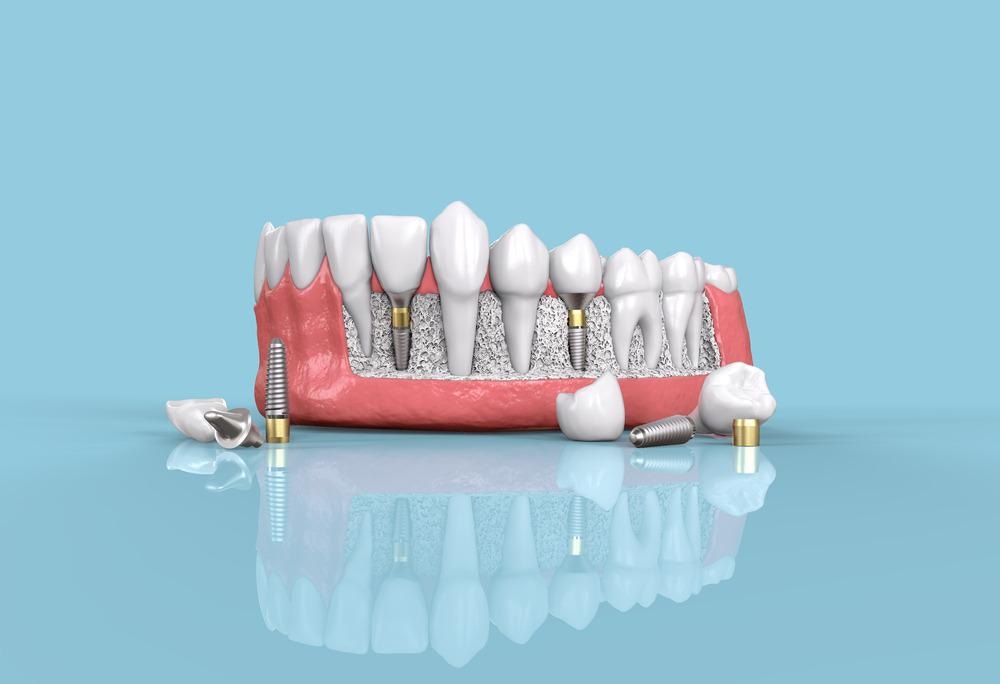Scientists from Imperial College London and the University of Central Lancashire have published a new paper in the journal Dental Materials comparing different immediate post-placement particle releases from different dental implants. The paper will help researchers working in the field of dental health to design safer dental implants that avoid post-operational complications.

Study: Particle release from dental implants immediately after placement – An ex vivo comparison of different implant systems. Image Credit: vipman/Shutterstock.com
The Challenges with Titanium Dental Implants: Post-operative Concerns
Titanium and titanium alloys are commonly used for dental and orthopedic implants. This material is used as it is strong, biocompatible, and durable, and since the introduction of titanium dental implants in the mid-1960s there has been a high treatment success rate using titanium dental implants.
There are some concerns with the use of dental implants, however. Oral peri-implantitis is a common postoperative complication, and problems can occur such as potential bone resorption and loss of implants. This condition has become a research focus in the field of dental medicine.
Oral peri-implantitis was long thought to be caused by the presence of pathogenic oral bacteria, but in recent years evidence has emerged that it is associated with aseptic inflammation at the implant site. Metallic ions and particle release from implants seem to be the cause of this condition. Metallic particle release can occur when implants are screwed into the bone, as well as being released by surface corrosion and normal wear conditions.
Due to there being no established treatment protocols for oral peri-implantitis, controlling the condition is problematic once it occurs. Whilst titanium implants themselves are considered non-toxic, the ions and particles released themselves may be harmful, which can cause further health complications in patients such as chronic inflammation, frustrated phagocytosis, and potentially osteolysis. Implant failure can occur, leading to the need for further surgical intervention and loss of quality of life for the patient.
Researchers have discovered the presence of metallic particles from orthodontic and orthopedic implants in the lungs, spleen, liver, and bone marrow. This could lead to further health complications for patients. Studies are ongoing into investigating the effects of metallic particle release on human health and designing strategies to overcome this issue.
The Paper
In the paper, the authors have used an ex vivo pork mandible bone model to systematically evaluate the impact of metallic particle release from dental implants. The impact of implant material composition and geometric design on particle release immediately post-placement has been investigated in the research. Materials used in the research were all bone-level implant designs.
Metals evaluated in the research were commercially pure titanium, titanium-zirconium alloy, and a titanium-aluminum-zirconium alloy. Tapered or cylindrical geometries were compared. Furthermore, in vitro investigations of peri-implant internalization of metallic elements by human macrophages and gingival fibroblasts were conducted in the paper.
Results of the Study
The authors extensively investigated the effect of the different implants in the study. It was demonstrated in the paper that both geometry and materials selection influence the release rate of metallic particles and ions.
Increased release of metallic elements occurs in wider-diameter implants. This was also demonstrated to be significantly more in titanium-aluminum-zirconium alloys than in commercially pure titanium and titanium-zirconium alloys used in implants with similar dimensions and design. In commercially pure titanium implants, tapered geometries release fewer metallic elements compared to cylindrical ones.
Results of the in vitro peri-implant cell internalization investigations demonstrated that all metallic particle types were absorbed by gingival fibroblasts and macrophages.
Significance of the Research and Future Perspectives
The research has demonstrated that commercially pure titanium and titanium-zirconium alloys are more suited to use as dental implants. Additionally, implants with narrower diameters and more tapered geometries (especially in commercially pure titanium) are more suitable. However, there are still some challenges that researchers need to address.
Future research will be needed to provide information on the effects of metallic species and/or fine particles released by dental implants post-procedure on patients. In-depth evaluation of dental implant materials and the risk potential of alloy constituents are vital for research into safer implants to avoid oral peri-implantitis and immune responses which could hinder their use, avoiding the need for further surgical interventions.
Due to the higher metallic element release from titanium-aluminum-zirconium alloys, cytotoxicity studies on this alloy should be a research focus in the future. Overall, this paper is a significant contribution to the field of dental research and the development of dental and osteopathic implants with fewer post-procedure complications.
More from AZoM: What is Bimodal Particle Size Distribution?
Further Reading
Barrak, F et al, (2022) Particle release from dental implants immediately after placement – An ex vivo comparison of different implant systems Dental Materials [online] sciencedirect.com. Available at:
Disclaimer: The views expressed here are those of the author expressed in their private capacity and do not necessarily represent the views of AZoM.com Limited T/A AZoNetwork the owner and operator of this website. This disclaimer forms part of the Terms and conditions of use of this website.